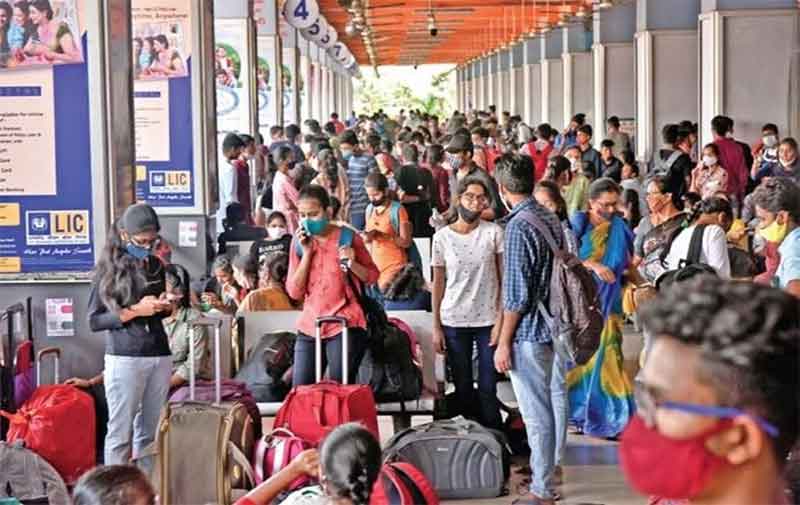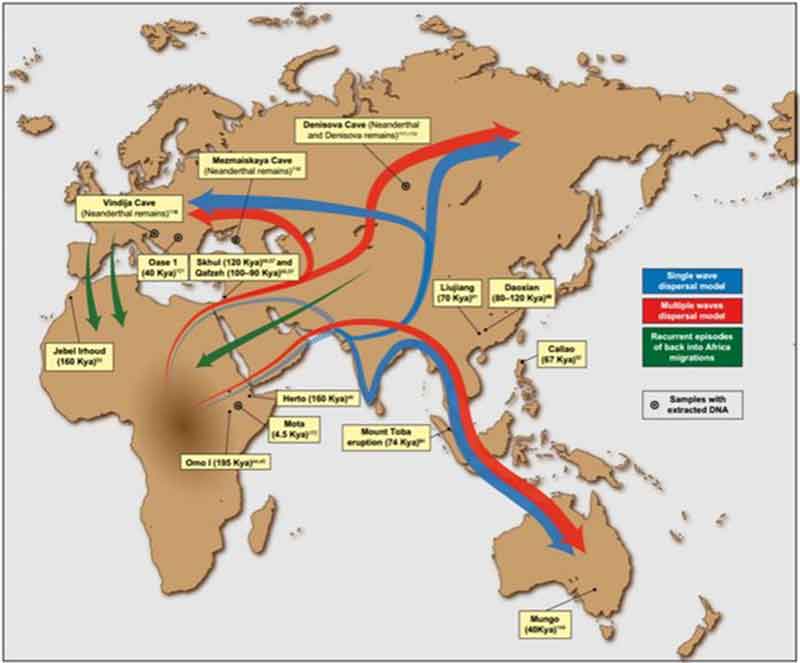
According to a recent statement by India’s Ministry of External Affairs, 1.3 million Indian students are studying outside India. Their educational expenses abroad are estimated to be more than USD 6 billion. Many of the student migrants settle down in destination countries and continue to contribute to their economies. There are varying approaches to understanding student migration from the source and destination countries. Some see it as a problem to be addressed, while others see these as opportunities to be capitalized.
Migration and population movements have always occurred in history. In the animal kingdom, all mammals including humans on our planet are genetically inclined to migrate from one place to another. In pre-historic times, humans were constantly moving with their cattle herds. Eventually, humans settled around their farmlands. People continued to migrate, mainly for 2 reasons:
· Because of Distress caused by ecological, political, and economic factors
· Because of their Disenchantment with the current systems in which they live and seek better prospects, freedom, adventure, and so on.
Understanding the second scenario, viz. ‘disenchantment’ will give us valuable insights into dealing with the issue of student migration from India. I will now present a case study of the Kerala State of India – migration from here mostly belongs to the latter category, i.e. disenchantment with the existing socio-economic system.
Migration has a key place in Kerala’s history. Thanks to its migrant population, the state enjoys a lifestyle and health status comparable to that of rich countries. The earlier migrants from the state were unskilled laborers who migrated to the Middle Eastern countries and built cities like Dubai and Abu Dhabi. Though the charm of these Gulf countries has recently come down due to competition from cheaper labor from the other South Asian countries, the Gulf region continues to be the favorite destination as 89.1% of migrants from the Kerala state live in 6 Gulf countries.
As per the recent Kerala Migrant Survey (2023) by the Gulati Institute of Finance and Taxation:
· Kerala has 2.2 million emigrants today, which is 6% of the state’s population
· Out of this, 11.3% or 250,000 are young students. Their numbers have doubled in the past 5 years.
· 80% of migrated youth are graduates, and their age range starts at 17 years.
· If we look at the gender distribution of these young students, Male migrants constitute 54.4%, and Females constitute 45.6%
Now, where are these young people going?
· They are mainly going to the UK (one/4 students), Canada (1/5 students), the USA, Australia, and New Zealand.
· They are also going to many other countries including Mexico, Iceland, Vietnam, Kyrgyzstan, Barbados, Slovenia, Slovakia, and so on.
Why do youth go for higher studies abroad? Two recent studies throw enough light on that.
1. A study titled Youth and Migration Aspiration in Kerala (conducted in 2022) by Sulaiman KM and Bhagat R.B.
2. A study by the Centre for Public Policy Research (2023), titled Youth Migration in Kerala.
Both these studies assert that in the coming 10 to 20 years, migration will continue as a potential life choice for achieving life goals for youth in Kerala. It is mostly the desire for high-quality education and better career opportunities that tempt the youth to go for higher education abroad. According to the Sulaiman and Bhagat study, “two out of three youths in the sample aspired to migrate abroad in the future for a job and related activities”.
The Centre for Public Policy Research study found that 45% of the migrated students considered migration as a pathway for success and were disenchanted with the current situation in the state. However, it may be noted that the current education system in the state is perhaps the best in the country if we go by the rankings given to academic institutions in the state by reputed agencies. For example, 15 out of the top 100 colleges ranked by the Government of India’s NIRF ranking are in Kerala. Interestingly 5,706 first-year degree course seats remained unfilled out of a total of 16,358 in 2023 at Mahatma Gandhi University which is one of the high-ranking universities in the state.
Kerala is one of the states that attracts the greatest number of immigrants from other states of India as the state has the highest minimum wage for unskilled workers. In some cases, the state has wages comparable to Gulf countries for manual labor. There is a steady ‘migration’ of domestic migrants from north Indian states into Kerala to do manual labor. Their number is estimated to be 3 million plus, and this has already started changing the demographic situation of the state.
However, the youth in the State are not interested in taking up manual labor. They think the state lacks suitable job opportunities and there exists a mismatch between their aspirations, qualifications, and salary available in the state.
Earlier, I said 45% of the migrated students considered migration as a pathway to success. 78% of women in this 45% are seeking a society that promotes inclusivity, offers a better lifestyle, and is free from social stigmas and stereotypes. The findings of the study indicate a strong disenchantment with Kerala’s existing social framework dominated by patriarchal values and a tendency to control women’s free, social, and physical movement. As a result, young women see migration as a platform for empowerment, freedom, and change.
Easy loan availability, thanks to the efficient banking system in the state, is a facilitating factor in increasing youth migration. It may be noted that 60% of the migrant students in the Centre for Public Research study hail from families earning less than USD 5900 annually. There are numerous agencies located in small and big towns of the state to support language learning, complete all the paperwork and home deliver visas. In almost all cases family support for migration was reported as a key facilitating factor.
The life of migrated students is not free from challenges. Quite often there are huge discrepancies in what they expect and what they get at the destination. Adapting to a new culture and dealing with financial liabilities at home have created tensions. Finding suitable accommodation and getting the right job after studies etc. are also challenges. Many of the youth migrate without definite plans and goals after their studies.
Immigration in general was always helpful for the state. In 2023, Kerala received 25.69 billion USD in remittances from migrants, which was a 154.9% increase from 2018. This has contributed 23.2% to the state’s domestic product. However, experts predict that this trend will not continue in the case of students who migrate to the West as most students will stay back and their expenses to settle down and continue there as a first-generation migrant will disturb this steady flow of remittances.
Most of those who return from destination countries are Distress returnees. In 2018 Kerala saw 1.2 million migrants returning and in 2023, 1.8 million migrants returned to the state. The primary reason for returning was job loss or not finding an appropriate alternate job. The state needs policies to re-integrate the returnees with appropriate opportunities.
Many of the young migrants leave behind their parents at home. Some of these parents have already become senior citizens crossing their sixties and need support in dealing with many issues such as loneliness, anxiety, and depression. According to a recent study by Cochin University, 6% of the state’s 3 million elderly are alone. Some of the migrated people have taken their parents along with them, leaving many huge houses in Kerala unoccupied. I have already mentioned the underutilized educational infrastructure already existing in the state. Abandoning more infrastructures of academic institutions in the state cannot be ruled out in the long run.
Migration of youth from the state will continue in the coming decade. States in both the origin as well as in the destination have a key role in making migration a mutually useful process for both the migrants as well as the hosts. The state must provide agencies and resources for safe migration pathways and rigorously monitor language training centers and recruitment agencies.
Kerala may also consider enriching its educational infrastructure by matching it with existing industry opportunities in the state. A key aspect of disenchantment, especially for women in the state is their disenchantment with certain cultural values that keep them under bondage. Policy dialogues in the state will have to reflect more on how to support girls in the state in living in a progressive, inclusive, gender-sensitive society in the coming days.
Subscribe to Our Newsletter
Get the latest CounterCurrents updates delivered straight to your inbox.
Kerala’s experience is not necessarily a typical Indian experience. But it can provide insights on the disenchantment migration of students taking place in India. The socio-economic system in the country must catch up with the ever-increasing aspirations of the youth. When that does not happen, they will be disenchanted and seek opportunities elsewhere.
(This article is based on a speech the author delivered at the International Policy Dialogue on Migration Development held on 19 November 2024 at the OECD Development Centre, Paris)
Kandathil Sebastian is a social scientist and author based in New Delhi












































